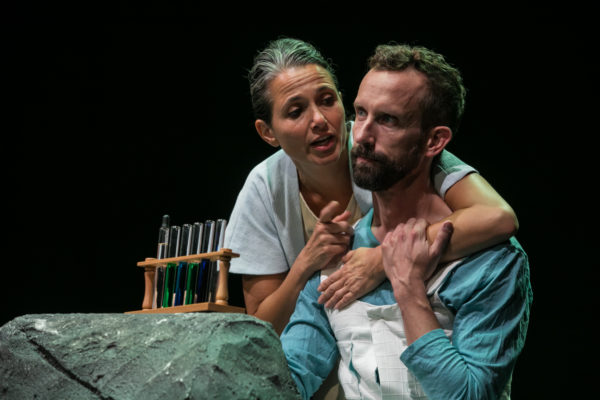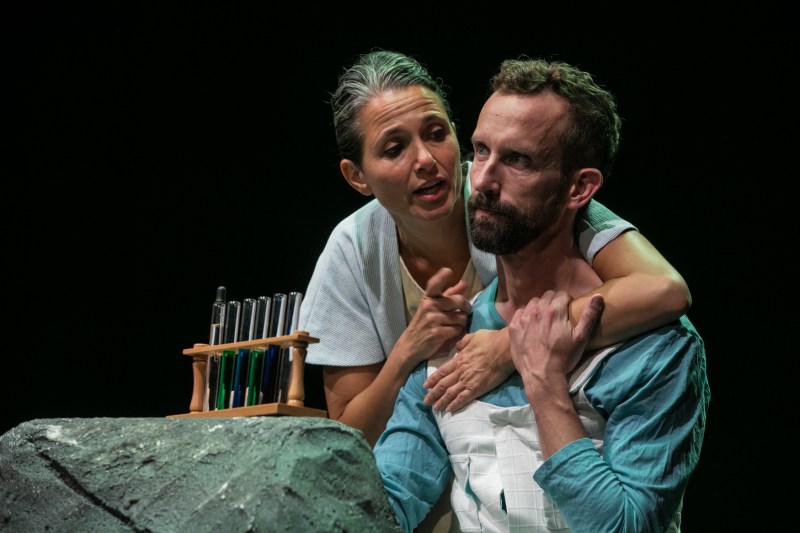
The works of Obie Award-winning Bay Area playwright and all-around theater magician Christopher Chen never fails to confuse, enlighten and surprise audiences. If you’ve ever seen that GIF of Chris Pratt as Andy Dwyer on “Parks and Recreation” gasping and looking into the camera as it zooms in, that’s a relatively accurate summation of my reaction to Chen’s work. The Asian American Theater Project’s winter 2017 production of Chen’s Obie Award-winning play, “Caught,” first introduced me to his work. “Caught” is an incredibly mind-blowing, complex play with layers that never seem to stop unraveling, filled with deceit and faltering on the truth. “A Tale of Autumn” does something similar, albeit on a less ambitious scale. Produced by San Francisco’s Crowded Fire Theater and directed by Mina Morita (who will be directing the TAPS department’s spring main-stage production, “The Good Person of Szechwan”), Chen’s newest play is not an exception. While it doesn’t achieve the same level of clarity as a piece such as “Caught,” “A Tale of Autumn” is thought-provoking and a startling reflection of how human systems and interactions are more deeply-rooted and complicated than they might appear.
Framed within a Hunger Games-esque dystopian society, “A Tale of Autumn” tells of the leaders of Farm Company — colloquially known as Farm Co. — a corporation that started out, as the name implies, an agriculture company, but has now expanded out to nearly dominate the entirety of the private sector. With the death of its founder and CEO, Farm Co.’s leaders scramble to take control, their motives and directives hazy for both the audience and even themselves. Chen’s ability to weave in a certain discernible mirroring in scenes is simply incredible, such as a number of scenarios with repeating dialogue in vastly different situations or similar ideology leading to tragically different outcomes and belief systems. Especially in “A Tale of Autumn,” those reflections are extremely important and ultimately a foundation of the production itself. I was able to feel a certain level of discomfort when characters began to betray each other or stray from their carefully constructed facades — and that’s when I knew the play was doing its magic.

With scenic design by Adeline Smith, “A Tale of Autumn” leaves the stage extremely bare, including only a tiered platform in the center of the stage and three stones that act as tables and chairs throughout the production. With no other set pieces brought onto the stage during the entire performance, the minimal set dressing forces the audience to interact and engage more closely with the characters in all their raw moments. Contributing even more of a dystopian feel is costume design by Miriam R. Lewis — using vibrant colors strung together in unconventional ways, each character’s clothing felt like a mashup between Roman Empire-era clothing and formal clothing of today. This choice was particularly fascinating especially between the higher class, more patrician characters of Farm Co. and the working class plebeian individuals, who wore more simple, looser and less angularly cut clothing. As the play progressed, the production design also became more and more symbolic. Sound and video design by Theodore J.H. Hulsker — most notably the progressions shown on the many cloth panels hung from the ceiling — shifted from scrolling phrases depicting large events in the story to water droplets and eventually to strong visual patterns that complemented character emotions. The projections in the latter half of the production were aesthetically stronger as the motives of characters became more and muddled, creating an emotionally visceral environment for audience members.
Nevertheless, I was left hanging with a number of characters whose stories and paths evolved in an unfinished way. Even if this was intentional, some of the character plot lines felt sufficiently rounded-out, leading me to struggle to comprehend why the others were not similarly completed. With the apparent protagonist introduced much later in the play than other contemporary works, “A Tale of Autumn” felt more ensemble-based, which is why tossing away characters mid-play felt unnatural. With such a deep investigation of political motivations and power struggles, I wanted to know more about the smaller characters after becoming so distraught over the lead Farm Co. savior turned eventual villain — or so we think.
“A Tale of Autumn” is one of Christopher Chen’s complicated, brain-wrenching and morality-twisting plays. While not altogether as cohesive as it could have been, “A Tale of Autumn” gives attendees a good taste of a form of political theater — a shocking reflection of our own society, lives and inner workings of our minds. Something about Chen’s works are simply incomprehensible — if you have a chance to see his works in the area, go see them — you might not think about the world in the same way again.
“A Tale of Autumn” closed at Crowded Fire Theater in San Francisco on Saturday, Oct. 7.
Contact Olivia Popp at oliviapopp ‘at’ stanford.edu.
